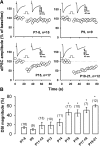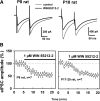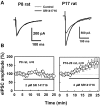Developmental alteration of endocannabinoid retrograde signaling in the hippocampus
- PMID: 20007500
- PMCID: PMC2822685
- DOI: 10.1152/jn.00327.2009
Developmental alteration of endocannabinoid retrograde signaling in the hippocampus
Abstract
Endocannabinoids are lipid derivatives that mediate paracrine and juxtacrine signaling between cells. In the hippocampal CA1 region, a retrograde endocannabinoid signal suppresses GABA release by acting on presynaptic cannabinoid receptor-1 (CB1) and can be functionally manifested as depolarization-induced suppression of inhibition (DSI). In the present study, whole cell patch-clamp recordings in hippocampal slices were made to examine DSI in rats from P7-P21. Robust DSI develops in rat hippocampus at postnatal ages greater than two weeks, but only modest DSI is observed in P7-9 rat. DSI in neonatal rats can be enhanced by activation of group I metabotropic glutamate receptors (mGluRs) or muscarinic acetylcholine receptors in those neonatal rats. The DSI is also enhanced by sustained low-frequency (1 Hz) stimulation (5 min). This stimulus-enhanced DSI was prevented in the presence of 6-methyl-2-(phenylethynyl)-pyridine (10 microM), a group I mGluR antagonist. WIN55212-2, a synthetic CB1 agonist, produced a similar level of inhibition of GABAergic synaptic transmission at different postnatal time points. Therefore postsynaptic mechanisms appear to be mainly responsible for developmental changes in DSI, although presynaptic mechanisms cannot be ruled out entirely. We have also obtained evidence that tonic endocannabinoid release suppresses GABAergic transmission in the mature but not the neonatal hippocampus. The differential DSI magnitude at different stages of maturation could alter synaptic plasticity and learning and memory during hippocampal development.
Figures






Similar articles
-
Endocannabinoid- and mGluR5-dependent short-term synaptic depression in an isolated neuron/bouton preparation from the hippocampal CA1 region.J Neurophysiol. 2008 Aug;100(2):1041-52. doi: 10.1152/jn.90226.2008. Epub 2008 May 21. J Neurophysiol. 2008. PMID: 18497350 Free PMC article.
-
Cooperative endocannabinoid production by neuronal depolarization and group I metabotropic glutamate receptor activation.Eur J Neurosci. 2002 Mar;15(6):953-61. doi: 10.1046/j.1460-9568.2002.01929.x. Eur J Neurosci. 2002. PMID: 11918654
-
Postsynaptic M1 and M3 receptors are responsible for the muscarinic enhancement of retrograde endocannabinoid signalling in the hippocampus.Eur J Neurosci. 2003 Jul;18(1):109-16. doi: 10.1046/j.1460-9568.2003.02732.x. Eur J Neurosci. 2003. PMID: 12859343
-
Endocannabinoid-mediated short-term synaptic plasticity: depolarization-induced suppression of inhibition (DSI) and depolarization-induced suppression of excitation (DSE).Br J Pharmacol. 2004 May;142(1):9-19. doi: 10.1038/sj.bjp.0705726. Epub 2004 Apr 20. Br J Pharmacol. 2004. PMID: 15100161 Free PMC article. Review.
-
DAG lipase involvement in depolarization-induced suppression of inhibition: does endocannabinoid biosynthesis always meet the demand?Neuroscientist. 2010 Dec;16(6):608-13. doi: 10.1177/1073858410373281. Epub 2010 Sep 13. Neuroscientist. 2010. PMID: 20837870 Review.
Cited by
-
Developmental regulation of fear learning and anxiety behavior by endocannabinoids.Genes Brain Behav. 2016 Jan;15(1):108-24. doi: 10.1111/gbb.12253. Epub 2015 Nov 5. Genes Brain Behav. 2016. PMID: 26419643 Free PMC article. Review.
-
Self-tuning of inhibition by endocannabinoids shapes spike-time precision in CA1 pyramidal neurons.J Neurophysiol. 2013 Oct;110(8):1930-44. doi: 10.1152/jn.00099.2013. Epub 2013 Jul 31. J Neurophysiol. 2013. PMID: 23904493 Free PMC article.
-
Developmental trajectory of the endocannabinoid system in human dorsolateral prefrontal cortex.BMC Neurosci. 2012 Jul 24;13:87. doi: 10.1186/1471-2202-13-87. BMC Neurosci. 2012. PMID: 22827915 Free PMC article.
-
Endocannabinoid signaling and synaptic function.Neuron. 2012 Oct 4;76(1):70-81. doi: 10.1016/j.neuron.2012.09.020. Neuron. 2012. PMID: 23040807 Free PMC article. Review.
-
Endogenous cannabinoid signaling at inhibitory interneurons.Curr Opin Neurobiol. 2014 Jun;26:42-50. doi: 10.1016/j.conb.2013.12.006. Epub 2013 Dec 28. Curr Opin Neurobiol. 2014. PMID: 24650503 Free PMC article. Review.
References
-
- Bolshakov VY, Siegelbaum SA. Postsynaptic induction and presynaptic expression of hippocampal long-term depression. Science 264: 1148–1152, 1994 - PubMed
-
- Carlson G, Wang Y, Alger BE. Endocannabinoids facilitate the induction of LTP in the hippocampus. Nat Neurosci 5: 723–724, 2002 - PubMed
-
- Chevaleyre V, Castillo PE. Heterosynaptic LTD of hippocampal GABAergic synapses: a novel role of endocannabinoids in regulating excitability. Neuron 38: 461–72, 2003 - PubMed
-
- Collard KJ, Edwards R, Liu Y. Changes in synaptosomal glutamate release during postnatal development in the rat hippocampus and cortex. Brain Res 71: 37–43, 1993 - PubMed
-
- Defagot MC, Villar MJ, Antonelli MC. Differential localization of metabotropic glutamate receptors during postnatal development. Dev Neurosci 24: 272–282, 2002 - PubMed
Publication types
MeSH terms
Substances
LinkOut - more resources
Full Text Sources
Medical
Miscellaneous

